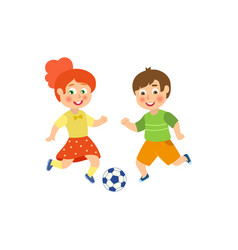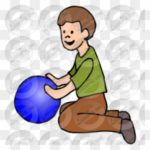
by Neetu | Jul 1, 2020 | Sports
Aim
- To reinforce the dribbling skills of football.
Equipment Required
- Spot markers
- Foam/soccer balls (1 per each student)
- Cones
- Upbeat music
Play Area Set-Up
- Place cones in a large circle and scatter spot markers around the outside of the cones/circle. (No one is allowed on the inside of the cones/circle.)
Activity Description
- On the cue of music, have the students dribble the soccer balls, moving clockwise, around the circular track.
- (Start with a speed limit of walking.) When the music stops, each child traps her/his ball on a spot marker. Students continue dribbling to the cue of music.
- Note: Periodically change directions so children practice moving in both clockwise and counterclockwise pathways.

by Neetu | Jul 1, 2020 | Sports
Aim
“It” chase and try to tag others with the given foam ball/football.
Equipment Required
- Four boundary cones
- Spot markers
- Foam/footballs
- Music Player
Play Area Set-Up
- Mark off a grid or circle.
- Everybody has a ball.
Activity Description
- Very simple and surprisingly effective.
- Whoever is “it” must dribble to another player and tag him/her.
- The other players avoid being tagged by dribbling away from “it.”
- If the player being chased loses her ball outside the grid, dribbles out of the grid, or is tagged, he is “it” and the game continues.
Note: – At least choose three to five “it”.

by Neetu | Jul 1, 2020 | Sports
Aim
The objective of the game is competition between groups.
Equipment Required
- Four Boundary cones.
- 2 small cones/spots per group.
- 1 football per group.
Play Area Set-Up
- Assemble students on one end of your activity area.
- Make group with 4-6 students.
Activity Description
- The basic game is Team ‘A’ racing team ‘B’ by dribbling through a series of gates. If a player loses control and misses a gate they should regain control and go through the gate.
- One variation is to have a small ‘square’ at the end.
- The children should stop the ball in the square, then sprint back and high-five the next player before he/she can start.
- Another variation is to have several parents positioned at different places along the ‘course’ and have a different one hold up a number of fingers at random times during the race – and award points to the player that sees it and correctly yells out the number first.
- This encourages the children to play with their heads up.

by Neetu | Jun 26, 2020 | Sports
Aim
Aim of activity is to give children the opportunity to practice the skill of kicking a ball as far as possible.
Equipment Required
- Four cones for a boundary.
- Spot marker.
- Foam or soft covered soccer ball for every child.
- Descent area to make them play.
Play Area Set-Up
- Tell them to make a single line on the perimeter line.
- Give a spot marker to everyone.
Activity Description
- Initially ask children to place the ball on the ground and ask that they take one step back and kick the ball hard and as far away as possible.
- Children then retrieve the balls and kick again.
- After children get the idea of kicking far, ask that they take several steps back away from the ball and run toward the ball and kick it. It may be helpful to place cones or markers out in the field so that children have a direction in which to kick. A marker or cone in the field can also be used to challenge children to kick farther.
- “Show me how far you can kick the ball. See if you can kick the ball past the cones.” Initially place cones about 10 to 12 yards away.
Variations
- As children get the basic concept of kicking far and hard ask that they travel throughout the grassy area continually kicking their ball. “Kick your ball far and then run up and kick it again.”

by Santosh | Jun 25, 2020 | Soccer, Sports
LEARNING OUTCOME
To improve control, dribbling, awareness, change pace, change of direction and turns
TEACHING CUES
- Head up / vision / awareness of space
- Encourage lead player to lose his shadow with a change of pace, a change of direction, zig zagging, dropping the shoulder / feinting, cut backs, etc.
ACTIVITY SET-UP AND PROCEDURE
EQUIPMENT:
Marked area, balls.
SET-UP:

ACTIVITY PROCEDURES:
- Mark off an area suitable for the number of players. Players are put in pairs.
- The aim of the game is to lose your shadow.
- If players can get more than 2m away from their shadow (partner) they receive a point.
- Continuous practice for 1 minute, then swap.
Progressions:
- Make the areas smaller or larger
- Give the lead player a ball
COOL DOWN/ CLOSURE
Review Skill/Activity, stretching, and questions.

by Santosh | Jun 25, 2020 | Sports, Soccer
LEARNING OUTCOME
To improve dribbling, running with the ball, awareness and turns.
TEACHING CUES
- Head up / vision / awareness of space
- Players on their toes anticipating their number being shouted
- Encourage dribbling player to lose on coming defender with a change of pace, a change of direction, zig zagging, dropping the shoulder / feinting, cut backs, etc.
ACTIVITY SET-UP AND PROCEDURE
EQUIPMENT:
Marked area, balls, bibs.
SET-UP:

ACTIVITY PROCEDURES:
- Mark off an area suitable for the age of the players.
- Mark out a central square using cones and place three balls in the centre.
- Split the team into four groups, with a group at each corner of the large area.
- Label each player within a group as number 1, 2 etc.
- The coach will shout a number; those numbered players run to the balls; turn and dribble back to their corner.
- The player who didn’t get a ball tries to steal one from the other teams.
Progressions:
- Make the areas smaller or larger
- Change numbers so players come up against different opponents
- The players with a ball get a bonus point if they can beat the player without a ball with a trick or piece of skill
COOL DOWN/ CLOSURE
Review Skill/Activity, stretching, and questions.













